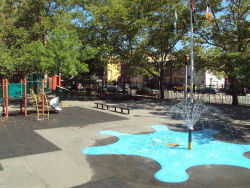Howard Playground
Howard Pool
For outdoor pool details, including hours and rules, please visit our Free Outdoor Pools page.
William Howard (1725-1777) owned the Rising Sun Tavern, also known as the Howard Halfway House because of its location between Brooklyn Village and the town of Jamaica at the intersection of the Bedford and Jamaica Turnpikes (now the corner of Broadway and Jamaica Avenue). The tavern lodged travelers, served as a gathering place, and sold basic supplies to the area farmers. Its design was unusual – the Rising Sun had two bars, segregated so its Dutch patrons would not have to endure the perceived indignity of drinking with their slaves.
A historical anecdote puts Howard inadvertently in the middle of a resounding defeat of American troops during the Revolutionary War. According to historical accounts, in August 1776, British General William Howe (1729-1814) was marching to the Battle of Brooklyn. He stopped at the Rising Sun Tavern and took Howard and his family prisoner in the middle of the night. Howard supported independence for the United States and did not want to help General Howe. He explained this to the general. “Stick to your country,” Howe replied, “or stick to your principles, but, Howard, you are my prisoner, and must guide my men over the hill.” Howard made to object, but the general cut him off. “You have no alternative,” Howe said. “If you refuse, I shall have you shot through the head.” So Howard and his 14 year-old son, also named William (1762-1854), guided the English troops along the Rockaway Path (which ran through what is now the Evergreen Cemetery), allowing them to avoid Jamaica Pass, which they thought was defended by American troops.
Jamaica Pass was only guarded by five men. They were supposed to raise the alarm at the approach of enemy forces, but the English, circumventing the pass with Howard’s aid, were able to take the Americans by surprise and capture them easily before they could escape. The British then attacked the American troops from behind their fortified position; the American army was nearly destroyed in its first military defeat and General George Washington was barely able to retreat from New York with his troops.
Howard and family remained prominent in the area even after the end of the Revolutionary War, and Howard Avenue was laid out on the Map of the City of Brooklyn in 1839 between Broadway and Eastern Parkway Extension. The avenue gave its name to the Howard Houses (1955), which passed it to Howard Playground (1956), and Howard Pool (1968).
In 1953, the city bought the property for Howard Houses to replace what were considered substandard homes. The original design for the houses provided for 10 buildings with 814 apartments, large green spaces, and a public park; Howard Houses opened in 1955. In 1968, the New York City Housing Authority provided Parks with land for the construction of a pool, replacing some of the original green space in order to provide more community recreation options.
Originally named Howard Houses Pool, the name was shortened to Howard Pool in 1987. In 1993, Mayor Giuliani funded a $2,131,000 renovation of the pool, and Borough President Howard Golden provided $90,000 for a new pool lining in 1997. The swimming pool measures 75 feet by 60 feet, and can accommodate up to 180 bathers at one time. The wading pool, which can hold up to 24 children, is 30 feet long and 20 feet wide. Dressing rooms are available for men and women, and the facility includes benches and drinking fountains.
Check out your park's Vital Signs
Clean & Safe
Green & Resilient
Empowered & Engaged Users
Share your feedback or learn more about how this park is part of a
Vital Park System

